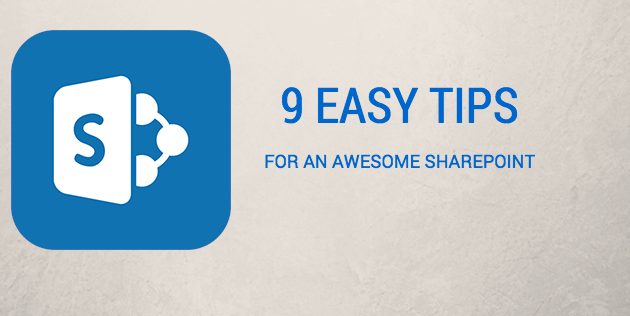SharePoint can be a great collaboration tool for government teams. Its familiar Windows interface makes it intuitive for many users, and it provides a lot more functionality than a file on a shared drive. So if you’re thinking about, or in the process of, setting up a site, here are nine tips for implementing SharePoint that can help ensure your project delivers on its promised benefits.
- Establish standards and rules: Prior to developing your site, you’ll likely set up a governance plan that outlines how to get from point A to point B, who will be involved in establishing the site, and what resources you’ll need by when. Your governance plan will help ensure that the project gets off the ground on time. But also important is establishing (and sharing) standards and rules for using the site once it is operational. You’ll especially want to create a document process. This will include how and where different documents will be stored (including file format and naming convention), versioning, and who can access the documents to make changes. It is important when doing this to set a standard that each document can only exist once on the site. You can link the single document into various folders, but you want to be sure that everyone is always working from the same version.
- Have a purpose: Make sure you understand why you are using SharePoint and what problem it is solving. This will ensure that you put in the appropriate capabilities and will make your site far more useful to those in your organization.
- Keep it simple: It doesn’t matter how technologically savvy you are, the average user probably isn’t. So make sure that you know the average skill set of your users and deploy solutions that aren’t too complex and speak to their needs.
- Know what you need to keep and what can go: Don’t bring everything over to your SharePoint site, because not every single piece of data or every single document has value. Allow this to be a fresh start.
- Have a simple rollout: Don’t feel like you need to deploy every functionality all at once. This can lead to delays for you and can be overwhelming for users. Instead, start with the basics, and as the need arises, implement new tools.
- Train your users ahead of deployment: The importance of training cannot be overstated. Educating users will greatly increase adoption, but it’s important that you do it right. Before rolling out your site, divide users into groups: who will be a casual user? Who needs to know how to manage the site or create new sites or workflows? Tailor your training to the various groups so that you do not confuse or overwhelm anyone. There are plenty of great, free online resources that you can use for training, like this one.
- Decentralize site management: Don’t let the users of the site just be visitors—establish a SharePoint management group that has representation from the various projects or teams using the site. Further, where possible, don’t let a single person or department be responsible for all aspects of the site. Whoever is in charge of the site should be mindful of how many updates/alerts/emails are sent regarding the site. Eventually, users will grow wary of a high volume of SharePoint email alerts and won’t pay attention to the most important messages you send.
- High-level tracking: Delegate a person (or a few people) to be in charge of keeping an eye on what’s being created or added to your site. This doesn’t need to be a full-time, document by document thing, it is really just someone to ensure that documents are not being repeatedly added, moved, or accidentally removed.
- Give the user opportunity: If you want to increase adoption, and ultimately productivity within the site, allow users the ability to develop lists, workflows, sites, libraries, etc. This doesn’t mean letting everyone do anything they want. See #1: user permissions should be outlined in your standards document.
What are your SharePoint tips? Leave them in the comments!





Leave a Reply
You must be logged in to post a comment.